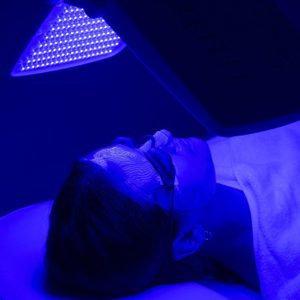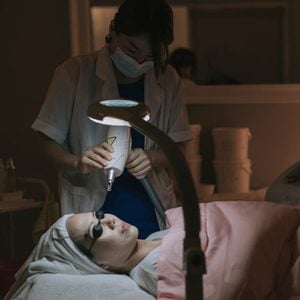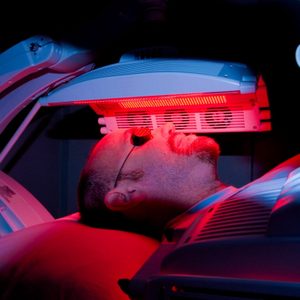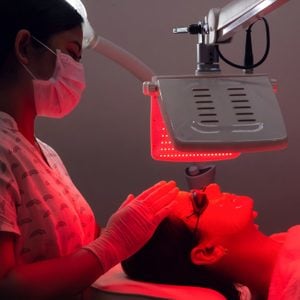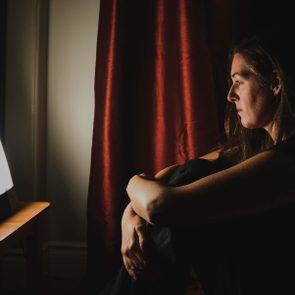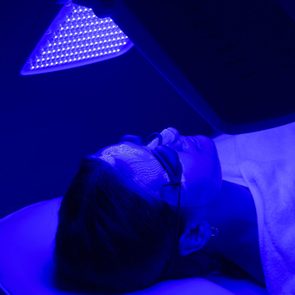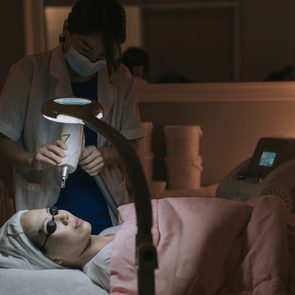What is UV Light Therapy? How It Helps Psoriasis and Other Skin Conditions
Updated: Jun. 21, 2021
Chronic skin conditions such as psoriasis and eczema can be challenging to treat. UV light offers an effective way to ease redness, itching, and flaking.
Using light for healing
Relying on light to heal is nothing new. “Light, specifically sunlight, has been used to treat skin diseases going back to people in ancient Egypt,” says Joel Gelfand, MD, chair of the National Psoriasis Foundation’s Covid-19 Task Force. And it’s still used today in treatment centers for a variety of skin diseases.
The most common form of ultraviolet (UV) radiation is sunlight. From sunlight, we get ultraviolet A (UVA) and ultraviolet B (UVB) rays. UVA provides the longest wavelengths of light, while UVB has shorter wavelengths. Excess exposure to UV rays via the sun or tanning beds can be harmful, leading to signs of aging and skin cancer.
When used to improve skin conditions like psoriasis, UV radiation is given with specialized devices that transmit light energy, rather than from the sun itself.
Light therapy
There are many different types of light therapy. Those include light-emitting diode (LED), BBL (BroadBand Light), IPL (intense pulsed light), and UV therapy. “Different wavelengths of light have different effects on the skin,” says Richard Flowers, MD, a dermatologist with UVA Health in Charlottesville, Virginia.
How UV light therapy works
Phototherapy, or UV therapy, uses UVB light (either broad-band or narrow-band) or a combination of psoralen (a light sensitizing topical) plus UVA light.
Light modulates the immune response in the skin, says Dr. Gelfand, who is also a professor of dermatology and epidemiology at the University of Pennsylvania Perelman School of Medicine, in Philadelphia. That’s especially useful for skin conditions where there is an underlying immune system disorder like psoriasis, eczema, chronic itch, and vitiligo (a condition in which the skin loses pigment cells).
(Here’s what you need to know about light therapy for rosacea.)
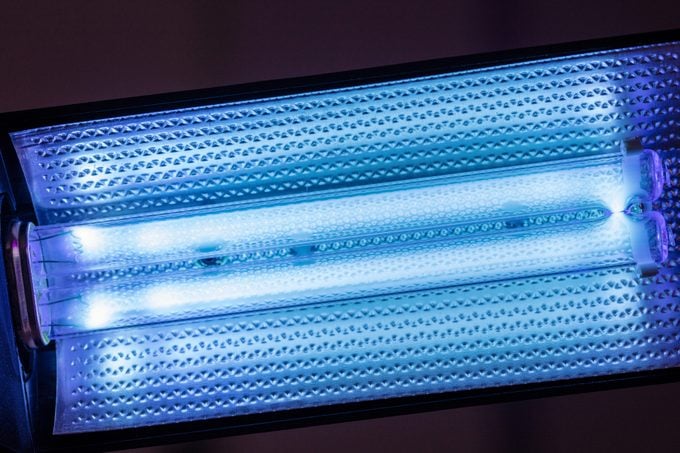
UV light therapy for skin conditions
Psoriasis
More than eight million people in the United States have psoriasis. This is an inflammatory skin condition that is caused by an immune system dysfunction.
For example, someone with psoriasis will experience their skin cell growth is in overdrive. These cells accumulate on the skin, leading to plaques and scales. Right now, experts don’t know what causes psoriasis.
Psoriasis can be treated with topical creams and ointments and oral or injectable medication. But these can come with side effects and don’t work for everyone. Many patients prefer UV therapy because they view it as a more natural treatment. It is also a safe and effective way to address symptoms. However, there are drawbacks when it comes to access, insurance coverage, and convenience. So it might not be the right choice for everyone.
(Here is the best skin care routine for psoriasis, according to dermatologists.)
Eczema
Eczema—which affects 31 million Americans—refers to any condition in which the skin is itchy, red, or develops a rash. The rough patches can be tough to manage. When topical creams and ointments don’t resolve symptoms, phototherapy is an option. Phototherapy—either via narrowband UVB or UVA light—can be used to treat a specific area of skin or for widespread symptoms over the body.
Vitiligo
By exposing skin to UVB rays, phototherapy can help trigger the production of melanin-producing cells to bring pigment back to discolored patches. It can also prevent vitiligo from worsening. This may be done as a full-body treatment that takes as little as five minutes, given one to three sessions per week, depending on severity.
Cutaneous T-cell lymphoma
This type of skin cancer is rare and it often mimics the appearance of eczema or psoriasis. UV light therapy can be used to damage cancer cells, and is given with a topical light-sensitizing medication plus UVA rays. Other topical treatments, as well as radiation, may be used. When caught early, this skin cancer is treatable.
More Stories About Light Therapy:
Effectiveness of UV light therapy
In many instances, UV light therapy can be quite effective when used alone or in combination with other treatments like topicals or medication.
“UV light therapy can potentially be the first-line therapy for psoriasis,” Dr. Gelfand says. “There have been careful studies of these therapies. Clinical trials show that phototherapy had a fairly similar clearing of skin compared to adalimumab (Humira), a commonly used, expensive biologic drug.”
What’s more, his research in a 2020 issue of Journal of the American Academy of Dermatology shows phototherapy improves patients’ self-reported quality of life. That may be because UV light raises endorphins, he says, or because the patient-nurse interaction when receiving phototherapy treatments makes you feel supported.
On the other hand, Dr. Gelfand says, areas of the body that normally don’t get light—like nails or a scalp covered with hair—aren’t as responsive to light therapy.
“Also, we do not treat the genitals with phototherapy due to this area being more prone to skin cancer from UV light,” he says.
(Here’s what you need to know about blue light therapy for acne.)
What about the sun?
One common question with light therapy is: Can’t you just go out into the sun?
“Many patients say that their psoriasis gets better in the summer with natural sunlight,” Dr. Gelfand says. “The problem is that the dose of natural sunlight is often not enough to be effective.”
What’s more, the sun includes wavelengths that can be harmful to skin, triggering burning, aging, or skin cancer. However, UV therapies that are used in-office are given through special machines that emit a small range of UV light. This is in order to treat the condition while lowering the risks to the skin.
(Avoid these sun damage habits.)
Risks and side effects of UV light therapy
If you’re undergoing UVB treatment, which will use either broad-band or narrow-band UVB light, there is a risk of sunburn from the UVB rays.
“This sunburn is usually pretty mild and goes away fairly quickly,” Dr. Gelfand says. “It’s uncommon for patients to get exposed in a way that would require medical attention for sunburn.”
In theory, UV light exposure should increase the risk for skin cancer over time. But research to date does not see a marked increase in skin cancer when treatment is given with doctor supervision. There is also the risk of skin photoaging—sun damage that leads to signs of aging like wrinkles, discolorations, and sagging—with long-term use. Proper use of UV therapy will decrease the likelihood of those side effects.
(Here’s what you need to know about red light therapy for wrinkles.)
Office vs. at-home treatment
There are two ways to get UV treatment: in a dermatologist’s office and at home. There are pros and cons for each.
Office treatment
Going into the clinic for regular treatments can be a big commitment, particularly if you live far away from a center that offers it.
“It can take 20 to 30 treatments for psoriasis or eczema to start responding, and even longer for vitiligo in some cases,” says Dr. Flowers. “This isn’t a quick fix. But it is effective when used appropriately.”
Preparation for your treatment depends on how phototherapy needs to be given for your specific skin condition. But you’ll likely wear goggles to protect your eyes and maybe instructed to apply sunscreen to protect vulnerable areas of skin.
At-home treatment
Purchasing a machine for at-home use is certainly more convenient, says Dr. Flowers. And, he adds, these can be safely operated by the patient. However, these machines can be expensive, often costing from $3,000 to $5,000. Some insurance, such as Medicare, may cover the cost.
Past research published in the medical journal BMJ comparing the expense of office and home treatment reveals that at-home phototherapy devices can be cost-effective options.
The differences
Whether or not UV treatments are more or less expensive compared to biologic drugs (which are very expensive) is complicated. Different types of insurance have different rules on coverage. Also, this can differ by patient. For example, one patient may find that medication is cheaper than in-office phototherapy treatments while another may find the exact opposite, says Dr. Gelfand. If you were to disregard insurance coverage, phototherapy is a fraction of the cost of biologics, he says.
The bottom line
Your dermatologist can advise you about the treatments that are right for your skin condition while considering your insurance coverage. UV therapy might be right for you when used as a stand-alone treatment or included in your current treatment regimen.
(Read up on the signs you need a dermatologist.)

















